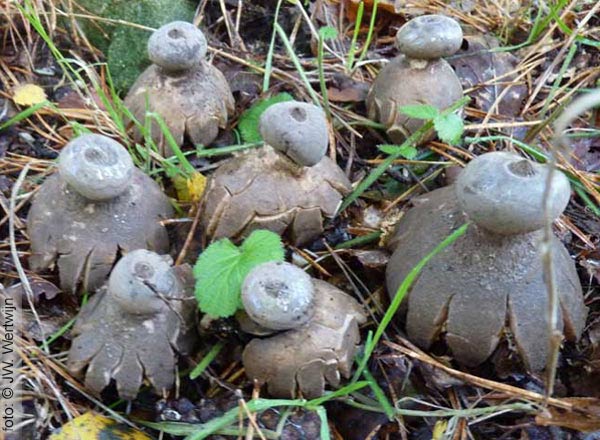
Photo: Beaked Earthstar, Vuursche dreef, guided tour KNNV-Gooi, October 3 2010 |
Beaked Earthstar
(Geastrum pectinatum)
NMV Ga 211090
This website's primary concern is the Amsterdam Area, incl. the pleistocene area
(Het Gooi) and parts of the Northsea dunal coast. |
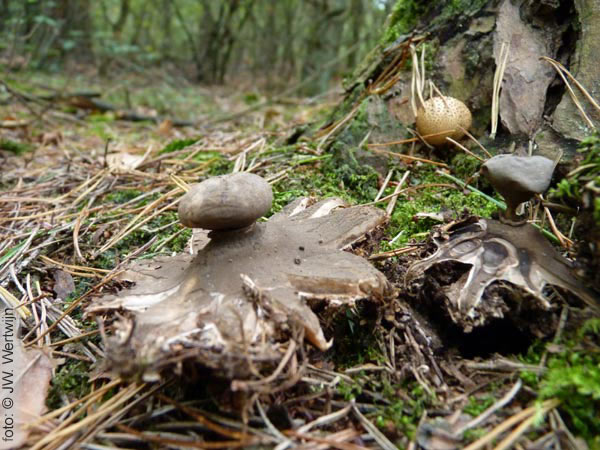
Photo: Beaked Earthstar, Zuiderhei (southeast of 't Bluk), September 17 2011 |
The first time someone made me aware of Beaked Earthstar was in the pleistocene area ('t Bluk)
at a bicycle track along Pinus sylvestris trees in 2001. Years later, during a guided tour (KNNV-Gooi, Vuurse dreef)
the knowledge had to be refreshed. Someone was sure this was doubtless Striate Earthstar.
What are the field marks of Striate Earthstar and how does this one differs from Beaked Earthstar ?
|
The Dutch common names for the two species make it more complex: Beret (=Striate) Earthstar versus Great (=Beaked) Earthstar.
What's a beret-shape (compared to other head-caps they have some kind of sleeve), and what should be great (earthstar-size compared to other earthstars)?
Habitat Beaked Earthstar:
Beaked Earthstar lives in forests near coniferous wood. That "forest" can be any combination of trees, as long as there is at least a
solitairy coniferous tree in the neighbourhood, so dunal bushes, parks and road-sides all may do well.
(Perhaps these conifers are the reason for another name for in, I found somewhere: Juniper Earthstar.)
Soil can be calcareous or non-calcareous, sand or clay, and dry till a bit moisty.
Most important field-mark: a thick layer of bad-wasting coniferous litter.
Wood species:
Coniferous woods (abies, juniperus, pinus, pseudotjuga)
|
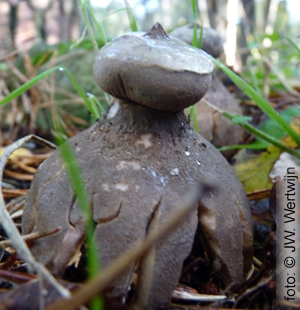
Photo: Beaked Earthstar, Vuursche dreef, guided tour KNNV-Gooi, October 3 2010 |
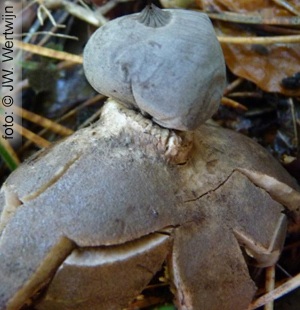
Photo: Beaked Earthstar, Vuursche dreef, guided tour KNNV-Gooi, October 3 2010 |
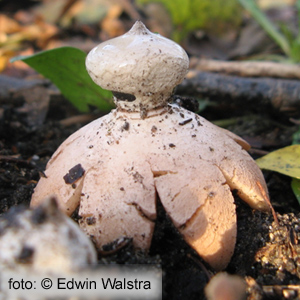
Photo: Beaked or Striate Earthstar ?
Is the meaty cylinder breaking (black line)? |
Mistakability (Similarity):
| |
Striate Earthstar:
Young Striate Earthstar may be a risk in the dunal area, and in dunal parts of the urban regio (sand suppletion), but not in the pleistocene area
(Het Gooi). Striate Earthstar lives in another kind of habitat. The difference becomes visible at age:
the shape of the apophyse is Sleeve-shaped.
Beaked Earthstar apophyse is Funnel-shaped.
The kind of beret (Dutch name translation of Striate Earthstar) meant is a navy beret, not a french farmer's beret (well known of commercials for French cheese).
The indent in the balloon together with the Sleeve-shaped apophyse form the beret.
Many Dutch people associate the indent in the balloon with the (french) beret (without sleeve),
and both species (Striate and Beaked Earthstar) often have an indent in the balloon when growing older.
Learning fungi is language learning.
The sleeve is not the meaty cylinder that hides the stem and the apophyse at younger age.
Both species do have such a meaty cylinder. As long as the cylinder is there, one cannot see the apophyse shape:
Sleeve-shaped or Funnel-shaped?
And now the main field-problem becomes clear: Exactly where starts the fissure of the meaty cylinder?
On top -> Beaked Earthstar? Somewhere in the middle ->Striate Earthstar?
Edwin Walstra made a photo of exactly that problem. The black stripe suggests the cylinder is fissuring from the balloon.
And you cannot see if it is a Striate or a Beaked Earthstar. Not Yet. A few hours later, I suppose, it would have been easy.
A temporary meaty cylinder, drying out to a little ring, is a field-mark for a group of Earthstar species.
Dwarf Earthstar, Striate Earthstar and Beaked Earthstar have it.
Rayed Earthstar, Crowned Earthstar
and Berkeleyi's Earthstar, for example, do not have it.
| |
| |
Dwarf Earthstar:
An old or dried out Dwarf Earthstar
has a much shorter stem, a rounded bag-shaped apophyse, just like Crowned Earthstar,
a much lighter colored balloon, and is a lot smaller than Beaked Earthstar.
But a few old and dried out Dwarf Earthstars really develop some Funnel-shaped apophyse, and that makes mistakability more reasonable.
| |
|
|
Mistakability in a book seems to be simple, but in reality in the field it is more complex.
In 2005 (in the pleistocene area) I have found a lot of Beaked Earthstars, young, old, different phases.
I made a photo report of these Beaked Earthstars.
- A young Beaked Earthstar can have fine cristalline grains on the balloon,
just like Crowned Earthstar, later the balloon becomes baldy.
- A young Beaked Earthstar can have a light-grey balloon,
just like Felty Earthstar, later the balloon becomes dark-grey.
- A young Beaked Earthstar can have thick star-rays, that look like star-rays of
Collared Earthstar,
Crowned Earthstar and
Rosy Earthstar.
- The Beaked Earthstar star-rays may have a rosy tint, but Beaked Earthstar does not change color upon injuring
(just like the ray-stars of Collared Earthstar and
Crowned Earthstar).
- The Beaked Earthstar stem seems to be developed out of the star-rays, and in the beginning the stem is short and broad
and there is no meaty cylinder at all.
- After time the meaty cylinder is developing, drying, and shrinking and the star-rays are bursting, and at the end of that growing-phase
it is possible to name the earthstar by field-marks. All earlier phases can sometimes be named by habitat-marks, not by field-marks.
If one is following a macroscopic key for mature earthstars, mistakability is impossible
because the mouth-zone of the balloon is already developed plicate-furrowy. But often the plicature develops during growth.
Collared Earthstar,
Crowned Earthstar, and
Rosy Earthstar do not have a plicate-furrowy mouth-zone.
Their mouth-zone is fibrillose (fimbriate).
A macroscopic key for mature earthstars based on mouth-zone normally has eliminated most other species before
Striate Earthstar, Beaked Earthstar
or Dwarf Earthstar.
|
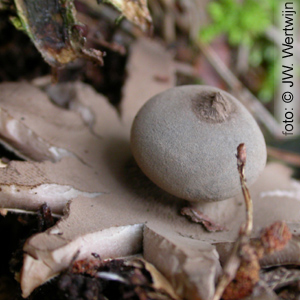
Photo: Beaked Earthstar, Zuiderhei (southeast of 't Bluk), October 9 2005
|
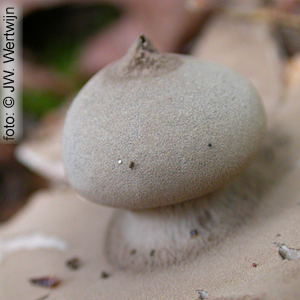
Photo: Beaked Earthstar, Zuiderhei (southeast of 't Bluk), October 9 2005
|
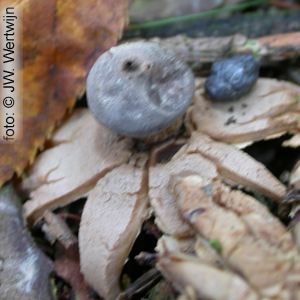
Photo: Beaked Earthstar, Zuiderhei (southeast of 't Bluk), October 9 2005
|
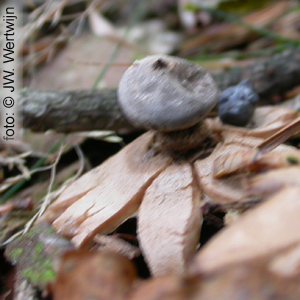
Photo: Beaked Earthstar, Zuiderhei (southeast of 't Bluk), October 9 2005
|
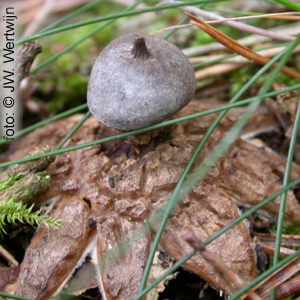
Photo: Beaked Earthstar, Zuiderhei (southeast of 't Bluk), October 9 2005
|
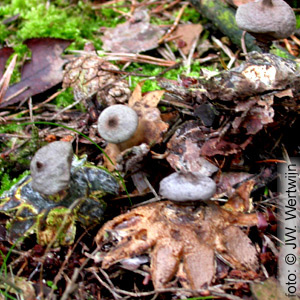
Photo: Beaked Earthstar, Zuiderhei (southeast of 't Bluk), October 9 2005
|
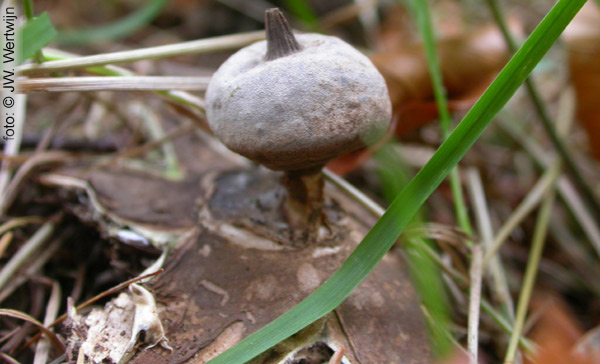
Photo: Beaked Earthstar, Maartensdijksche bos (Vuursche), October 28 2007
|
.jpg)
Photo: Beaked Earthstar (herbarium)
(notice apophyse with ring)
|
|
Field-marks: See: Anatomy Genus Geastrum
- Species size: average large
- Stem fresh: with temporary meaty cylinder (older the cylinder is drying out)
- Stem old (after drying): a ring around stem-basis (former meaty cylinder)
- Apophyse (below balloon): Funnel-shaped, stem pale-brown
- Balloon-surface young: with little cristalline flour
- Balloon-surface older: bald: glad
- Balloon-color young: light-grey
- Balloon-color older: dark-grey
- Balloon-mouth-zone young and older: conical
- Balloon-mouth-zone older: plicate-furrowy, sometimes with ring-furrow
- Star-rays-number: 6-10
- Star-rays fresh: upto 8mm. thick, with meaty top layer, light-creme, sometimes rosy
- Star-rays old: thin, brown
- Star-rays: non-hygroscopic
- Star-rays young: encrusted debris
- Star-rays old: bald (no debris)
|
Literature:
Chrispijn, R. ed. (1999), Champignons in de Jordaan (De paddenstoelen van Amsterdam), Schuyt en Co, 162-163.
Gerhardt (2006), De grote Paddenstoelen Gids (voor onderweg), Tirion Natuur, 616.
Hansen, L & K. Knudsen (1997), Nordic Macromycetes, Kopenhagen, Vol 3, 345.
Jalink (1995), De aardsterren van Nederland en België, Coolia 38 supplement, 59-60.
Pegler, e.o. (1995), British puffballs, earthstars and stinkhorns, an account of the british gasteroid fungi, Royal Botanic Gardens, kew, 1995, 255 pp.
Vermeulen (1999), Paddestoelen, Schimmels en Slijmzwammen van Vlaanderen, Wielewaal, Turnhout, 541.
www.mycobank.com
|
Top
|